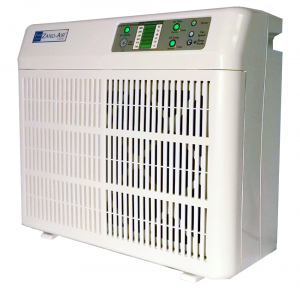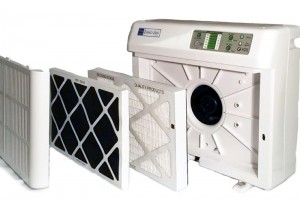 This system is a portable unit, specifically developed to meet the demands in the IVF laboratories.
This system is a portable unit, specifically developed to meet the demands in the IVF laboratories.
As technology has advanced, the necessity to filter air has become even more important.
No matter how well you maintain your laboratory, your work area can be filled with air pollutants, dust particles, mould spores, dander, pollen, dust mites, cleaning chemicals, volatile organic compounds (VOCs), chemically active compounds (CACs), aldehydes, carcinogenic materials, carbon monoxide, viruses and bacteria.
Add to these culprits the chemical irritants lurking about… in carpets from the front office, behind walls, from off-gassing in plastic materials, in the cleansers and waxes used to keep your laboratories and work surfaces clean. All these can have a direct influence on your results and on the health of laboratory workers. The key to effective air filtration of damaging volatile air compounds is in the Photo-Catalytic-Oxidation. The chemical compounds becomes highly reactive when exposed to a specific wavelength of ultraviolet light. The photo-catalyst attracts pollutants and converts them into benign compounds such as water (H2O) and carbon dioxide (CO2)
The ZAND-AIR Four Step Air Purification Process
 STEP ONE Adsorbs Toxic Chemicals and Gases
STEP ONE Adsorbs Toxic Chemicals and Gases
The front position Activated Carbon Filter with specially formulated gas adsorption media (including zeolite and potassium permanganate) adsorbs automobile exhaust fumes, organic hydrocarbons, formaldehyde from particle boards used in construction, paint, solvents, chlorine, cleaning chemicals, volatile organic compounds (VOCs), chemically active compounds (CACs) and other harmful agents.
STEP TWO: Hospital Grade HEPA Filter Removes Micro-Particles
A Back-Position Hospital Grade HEPA Filter individually tested by the supplier and certified to remove particles of 0.3 µm with not less than 99.97% efficiency by an approved aerosol. Pollen, mould, fungal spores, dust mites, and bacteria are examples of micro particles.
STEP THREE: Photo-Catalytic Oxidation Destroys Toxic Chemicals and Eliminates Odours
Photo-Catalytic-Oxidation converts toxic malign compounds (even carbon monoxide and nitrous oxide) into benign constituents such as water (H2O) and carbon dioxide (CO2). The catalyst is such that it does not wear out or lose its effectiveness as a result of its actions.
STEP FOUR: Ultraviolet Light
Ultraviolet light attacks the molecular structure of viruses and bacteria, which are too small to be filtered out by the HEPA filter, thus rendering them harmless. Ultraviolet light converts VOCs and CACs into H2O and CO2. Ultraviolet light technology combined with Photo-Catalytic-Oxidation is an important and unique feature of this air purification / filtration system.
 Electronic Sensors
Electronic Sensors
Electronic sensors monitor air quality and automatically increase the performance of the air purification system to compensate for periods of unusually high chemical activity and increased human activity.
Warning lights alert staff to the presence of toxic chemicals and fumes well before they reach dangerous levels or become detectable to the human senses. In the absence of high activity the air purification system can switch into a sleep mode and ‘wakes up’ as soon as it detects activity.
Photo-Catalytic Purification Cleans Air Down to the Last Molecule
The key to Photo-Catalytic-Oxidation is the titanium dioxide in the photo-catalytic chamber, where it becomes highly reactive when exposed to a specific wavelength of ultraviolet light. In the presence of organic pollutants, such as solvents, hydrocarbons, alcohols, carbon monoxide, dyes, and fuel oils, the activated photo-catalyst attacks the chemical bonds of the pollutants, converting the toxic compounds into benign constituents water (H2O) and carbon dioxide (CO2).
The UV lamp used in the 100C has an output in the 254-nanometer wavelength range. This wavelength destroys bacteria and viruses and does NOT produce ozone.
Ozone is not detected in any measurable quantity at the exit grill of an operating 100C. UV light is not reflected by most surfaces but adsorbed and thus cannot exit through the outlet grill of the 100C. The “blue” visible light seen when the unit is operating is characteristic for the UVC lamp, and is not an indication of UV radiation emission.
Technical Specifications: 100C
| Dimensions: | 21.5″w X 18″h X 8″d (55cm X 46cm X 20cm) |
| Weight: | 23 lbs. (10.43 kg) |
| Max Air Flow: | 265 cfm /7.5 m3 per minute |
| Max Watts: | 110 watts |
| Voltage: | 120v – 60hz /220v – 50hz |
| Blower: | Reversed – curved motorized impeller |
| Catalyst: | Metal oxides |
| U.V. Range: | 254 nm (produces no ozone) |
| Particle Filter: | 0.3 micron HEPA |
| Gas Adsorption: | Activated carbon media |
| Application: | 2,000 sq. feet max./185 sq. meters |
| Service: | U.V. Lamps -1 year, Filters – 6 months |
| Warranty: | 2 year limited warranty on all components excluding light and filters |
Catologue Number ZA 100C

Spares for ZA 100C
Filter Kit for the ZAND-AIR100C (HEPA & Carbon)
Cat No. ZA RK301
UV Germicidal Lamp for ZIVF-AIR 100C & 100P
Cat No ZA RK203
